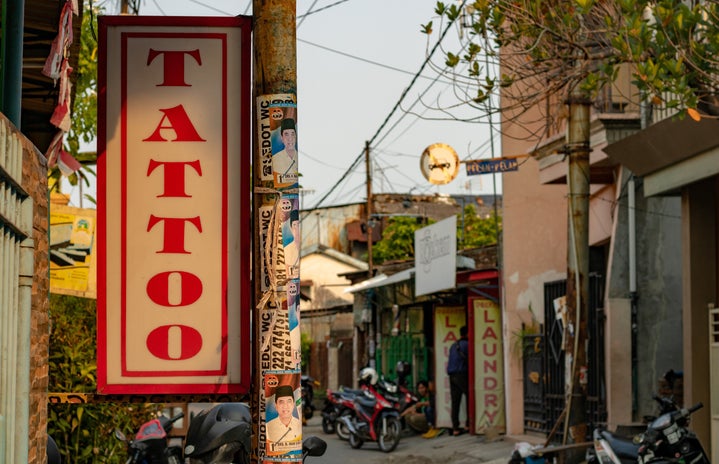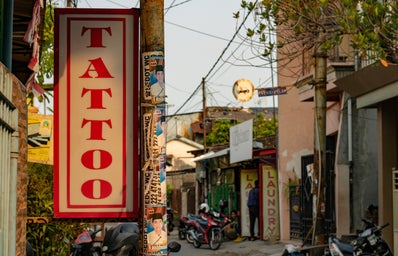A little heads up, some trigger warnings apply to this article as there will be mentions of suicide, self harm and sexual assault!
I’m sure that at some point in your life you’ve thought about getting a tattoo; maybe because they’re pretty or as a tribute to someone you lost or in appreciation of someone you love. Maybe you’re thinking about getting a tattoo because you had a traumatic experience and want to show how far you’ve come or that you’re stronger now or to love your body more. You’re definitely not alone!
We know the urge to get a tattoo, we recognize that it’s relatively universal, but do we really understand where that desire comes from? That urge to see and feel a symbol etched into our skin forever? From a psychoanalytical standpoint, it’s believed that your sense of self creates a body self while using the physical body as a blank slate. The body self becomes how your sense of self perceives the way your physical body looks. When an individual goes through a traumatic experience, the body self and the physical body begin to differentiate and disconnect to the point where they’re perceived as separate by your sense of self. This manifests as body-image issues. That divide leads to actions to try and reconnect; things like self-harming, eating disorders, substance abuse, etc. Your sense of self wants to see the same body in the mirror as the body self and will go through all of these things searching for that reconnection. This is where tattoos enter the conversation.
Not only is the process of getting a tattoo a very grounding, exhilarating experience, but also its aftermath; because, when you finally have a piece of the body self on the physical body, a connection appears. Your sense of self sees the tattoo on both bodies and begins creating more ties and reconciling more and more both bodies, effectively working to make the differences as minuscule as when it was first created.
This is the psychoanalytical explanation of course, but what it boils down to is appreciation and acceptance. It’s about wanting to heal and expressing yourself.
From the semi-colon to the Medusa, people use tattoos as a way to heal and help them move on from trauma. As a way to reclaim their body and establish independence. As a way to connect themselves to their body. Of course, to each person it might mean something different. Three people who survived suicide attempts might have tattoos that symbolize the extension of their subscription to life, but they don’t all have the same semi-colon. One could have the song they listened to that made them want to keep going, like myself, while another has a simple semicolon, and for another, it’s a semicolon hidden within an art piece that inspired them. Regardless of how they are executed or the symbolism behind them, they represent the same thing. A continuation. An acceptance of the event and a physical reminder that continuing is worth it. It represents healing.
For people with self harming tendencies and desires that are difficult to let go of, a tattoo could help in more ways than one. The planning of the tattoo gets them motivated to stop, so that the scars can be tattooed over. Then, once they have the tattoo, they’ll look at it and might think, “I don’t want to harm myself, I don’t want to ruin this beautiful piece of art.” The tendencies and desires might never leave, they might always be scratching at the back of their mind. And that’s okay because healing isn’t linear. Now they also have a tangible reason to continue staying clean, a reason to stay strong and a reminder that they are already strong enough. It’s also a reconciliation with their body and could boost self-esteem and body image. Beginning their journey towards loving and appreciating their body, scars and all.
Victims of sexual assault often compare the aftermath of the experience as feeling their skin marred, as feeling their body disconnected from themselves, as feeling a loss of autonomy. Tattoos help them to heal. The experience allows them to mark their body in the way they want. Getting a tattoo allows them to begin the road to accept that the experience happened and affected them, but that it doesn’t define them. They’re alive and healing. The experience allows them to reconnect with their body and establish their autonomy; be that with a Medusa as a symbol of protection or just a wonderful piece of art. The process itself of getting the tattoo allows them control over their body and where it’s being touched, which helps them to move on from the lack of control they felt, and remains, after the experience. The tattoos serve as the closing of a chapter and the beginning of a new life where that part of their life is firmly in the past.
Sometimes the tattoos carry double meanings. I was raised by relatively strict parents and grew up to be a very depressed, socially anxious person. Three times I considered and almost managed to end my life before the age of 19. At 20, I got three tattoos, each symbolizing the thing that made me want to keep going after each moment: reading, love and music. These tattoos also symbolize reclaiming autonomy over my body, which has never felt mine and as a way for me to establish my independence in the face of my parents. They also help me to think of my body in a positive light. They’re a firm declaration of my perseverance, will-power and desire for independence and a loud proclamation that I am a person with thoughts, opinions and the capability to make decisions for myself.
For each individual and each experience, the tattoo will be different, but the desire and end goal of healing remains a constant. Whether it has a deep meaning or they just want a pretty piece of art, tattoos are wonderful alternatives to much more dangerous coping mechanisms. They provide grounding, connection, decoration, conversation, experience, positivity to the person getting them. They mark unpleasant experiences and reframe them as beautiful pieces of art that help the person from the day they get them until forever. They represent acceptance and rebranding of the event as a way to move forward. So, don’t be sad, go get a tattoo!


